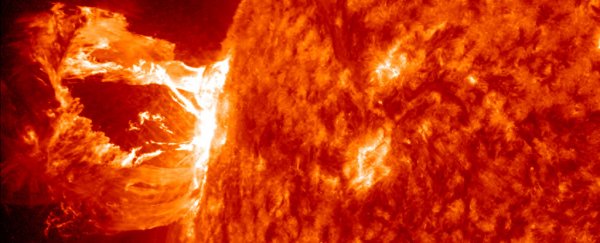If a powerful enough geomagnetic solar storm erupted from the surface of the Sun, it would be capable of knocking out communications across Earth for days, months, or even years. We likely wouldn't be harmed physically by such a calamity, but there's no telling how great the impact would be on the technology we use every day, scientists warned world leaders at a recent symposium on 'space weather' in Washington, DC last week.
There's no guarantee that such an event will happen while humans still walk the planet, but similarly powerful solar storms have occurred in the past – even relatively recently. The Solar Storm of 1859 – aka the Carrington Event – was caused by an intense solar flare hitting Earth's protective magnetosphere, causing telegraph systems across the US and Europe to break down (and even giving telegraph operators electric shocks).
The thing is, we weren't reliant on things like communications satellites, GPS, the internet, telephones, and air travel back then, and scientists estimate that if "the big one" hits us again, it could effectively send us back to the Dark Ages, technologically speaking. And given how much we depend on all that cool stuff these days, that might be something of a problem.
"Since the development of the electrical telegraph in the 1840s, space weather processes have affected the design, implementation and operation of many engineered systems, at first on Earth and now in space," solar-terrestrial scientist Louis Lanzerotti from the New Jersey Institute of Technology (NJIT) said at the conference.
"As the complexity of such systems increases, as new technologies are invented and deployed, and as humans have ventured beyond Earth's surface, both human-built systems and humans themselves become more susceptible to the effects of Earth's space environment."
According to Lanzerotti, beyond disrupting technological communications, a massive space storm could potentially corrode water and sewer pipelines, erase data stored in computer memory, and cause harm to astronauts travelling in space, unprotected by Earth's magnetic field.
From a financial perspective, insurer Lloyd's of London estimated the damage from such an event, lasting between one and two years, would range between $600 billion and $2.6 trillion.
But while it all sounds pretty terrifying, it's important to bear in mind that scientists say the chances of such a solar storm occurring are not high, calling it a "low probability but high-impact event".
Still, due to the potential dangers of "the big one", space weather specialists are talking with the White House and government agencies across the US including NASA, the Department of Homeland Security (DHS), and the Federal Emergency Management Agency (FEMA), to help prepare in case the unthinkable happens.
"The technological and biological impacts of severe space weather events are now firmly in the federal government's sights," Andrew Gerrard, director of NJIT's Centre for Solar-Terrestrial Research, said at the conference.
"All things being equal, increased research funding from the represented federal agencies will further bolster the incorporation of 'space weather' into our daily lives. Such developments will enable the solar-terrestrial community to, for the first time, see a solar storm, track its approach, and prepare accordingly."
